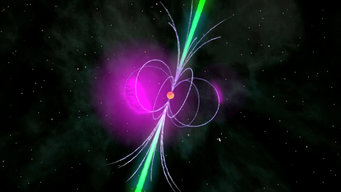Pulsars
This group's main research aspects are computing-intense searches for and studies of pulsars – rapidly spinning neutron stars – through gamma rays and radio waves in previously inaccessible parameter spaces using efficient data analysis and powerful computing resources.
Departure into unexplored lands
Pulsars are some of the most extreme objects in our Universe and important key probes for a wide range of fundamental physics. Yet many aspects are still poorly understood after decades of observations.
We extend neutron star searches to parameter spaces that have been inaccessible before on computational grounds. This requires the development of efficient data analysis methods and the exploitation of powerful computing resources, such as the Einstein@Home volunteer computing project. We adapt and improve methods from gravitational-wave searches for our gamma-ray and radio searches. We also study our discoveries at multiple wavelengths and messengers.
Gamma-ray pulsars

Pulsars have been primarily observed at radio wavelengths. Now gamma-ray observations with NASA’s Fermi Large Area Telescope (LAT) provide complementary windows of unprecedented opportunities to discover and study new pulsars. Thanks to the LAT, neutron stars can now be detected via their periodic gamma-ray pulsations alone. Many of them are invisible in the radio band. Surveying the gamma-ray sky, the LAT cataloged several hundred unidentified sources, among which many are thought to be pulsars.
Extracting new pulsars and science from LAT data is computationally limited and almost impossible with conventional methods. Long integration times are needed to detect regular pulsations in the photon arrival times. When the relevant pulsar parameters are unknown a-priori, they must be explicitly searched. For observations spanning multiple years, this requires a dense grid covering a multi-dimensional parameter space, with a tremendous number of points to be individually tested.
This resembles the computational challenge of finding continuous gravitational waves and has motivated the transfer and adaption of gravitational-wave methods to the analysis of LAT data for new gamma-ray pulsars.
Identifying gamma-ray pulsars in binary systems is computationally even more challenging. To enable targeted Einstein@Home searches for gamma-ray pulsars in binaries, we collaborate with the Jodrell Bank Centre for Astrophysics on optical observations of black-widow and redback candidate systems.
Radio pulsars

While most neutron stars have been discovered as radio pulsars, finding them in binary systems with short orbital periods is far more difficult. However, even one such discovery would be scientifically very rewarding because it would enable new tests of fundamental physics and studies of stellar evolution.
With methods inspired by gravitational-wave data analysis, our group uses Einstein@Home to search for these very short-period binary systems in the Galactic plane using data from the PALFA consortium and the Green Bank Telescope, and in globular clusters using data from MeerKAT.
Our group is a member of the “Transients and Pulsars with MeerKAT” collaboration. We are searching for new radio pulsars in unidentified Fermi-LAT sources. We also follow up newly discovered radio pulsars by searching for their gamma-ray pulsations.
Continuous gravitational waves
We collaborate with the Continuous Gravitational Waves group at our institute. We provide ephemerides of gamma-ray and radio pulsars for their targeted searches for gravitational waves from these neutron stars.
A multitude of discoveries
With these novel search methods developed at the AEI in Hannover, 39 previously unknown gamma-ray pulsars and 55 new radio pulsars were discovered and the following exciting findings were made:
Improved search methods for the future
Today, hundreds of LAT-cataloged sources remain unidentified, with a still growing number: some of these could be new types of gamma-ray pulsars. Their detection might require further extension and advancement of our search methods. The computational resources for these searches are significantly enhanced by using Einstein@Home.
New radio telescopes will make deeper and more sensitive observations of the radio sky. Our methods will contribute new radio pulsar discoveries in the growing amount of data.
















